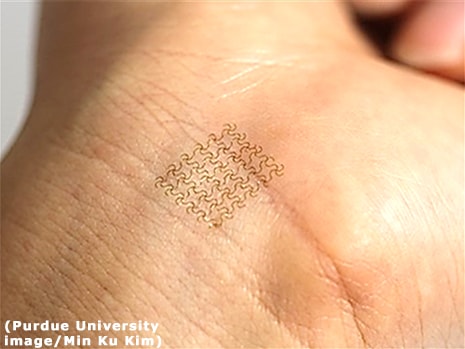Researchers from three universities come together to create a continuously monitoring skin patch
Orange County, CA - December 5th 2016 - A new electronic bandage has been developed that simulates the elasticity of human skin and its neurological capabilities. Created by researchers from Purdue University, University of Illinois at Urbana-Champaign, and Oklahoma State University, this highly flexible patch can be placed anywhere on the epidermis to observe biosignals for medical applications and provide therapeutic stimulation.
"Recording the electrophysiological signals from the skin can provide wearers and clinicians with quantitative measures of the heart's activity or the muscle's activity," said Chi Hwan Lee, an assistant professor of biomedical engineering and mechanical engineering at Purdue University.
Made up of conductive nanowire mesh and a thin layer of elastic polymer alternatively to the previous ductile metals such as gold and copper, the patch is unique. Previous materials suffered from cracking when over-stretched due to the thin film, however the nanowires composed from mesh are around 50 nanometers in diameter and more than 150 microns long. These are then coated in a temporary elastic polymer near 1.5 microns thick.

The polymer substrate is water soluble. Once applied to the skin, a small effusion of water droplets on the patch will dissolve the temporary polymer, leaving behind the securely adhered mesh to the skin. Another way this electronic bandage substantiates its superiority is its high surface area. Compared to its predecessors, the bandage possesses more than 1,000 times greater surface roughness to ensure no displacement of the device.
A crack-driven transfer printing technique, which Lee obtained a U.S. patent on, allows the device to be peeled from silicon and then placed on the skin. Direct contact of the device with the surface of the skin permits conductivity allowing researchers to measure signals from the heart (ECG) and muscles (EMG).
"Recording the electrophysiological signals from the skin can provide wearers and clinicians with quantitative measures of the heart's activity or the muscle's activity," Lee said.
Theoretical simulations were run to promulgate the underlying mechanics of the patch, and future research will be dedicated to the development of a transdermal drug-delivery bandage with corresponding technology. This would allow administration of medication through the skin in an electronically controlled manner. Measures for appropriate dosing are already under consideration and the team is looking forward to future prospects of practicability.
Read the full study here.
Contact Ampronix:

Email: info@ampronix.com
International Sales: +1 949-273-8000
Domestic Sales: 1800-400-7972 for US and Canada
Follow Us:
Share This Article:
View our Product Catalog Online Here
About Ampronix
Ampronix is a renowned authorized master distributor of the medical industry's top brands as well as a world-class manufacturer of innovative technology. Since 1982, Ampronix has been dedicated to meeting the growing needs of the medical community with its extensive product knowledge, outstanding service, and state-of-the-art repair facility. Ampronix prides itself on its ability to offer tailored, one-stop solutions at a faster and more cost-effective rate than other manufacturers. Ampronix is an ISO & ANSI/ESD certified facility. To learn more go here.
Researchers from three universities come together to create a continuously monitoring skin patch Orange County, CA – December 5th 2016 – A new electronic bandage has been developed that simulates the elasticity of human skin and its neurological capabilities. Created by researchers from Purdue University, University of Illinois at Urbana-Champaign, and Oklahoma State University, this highly flexible […]



